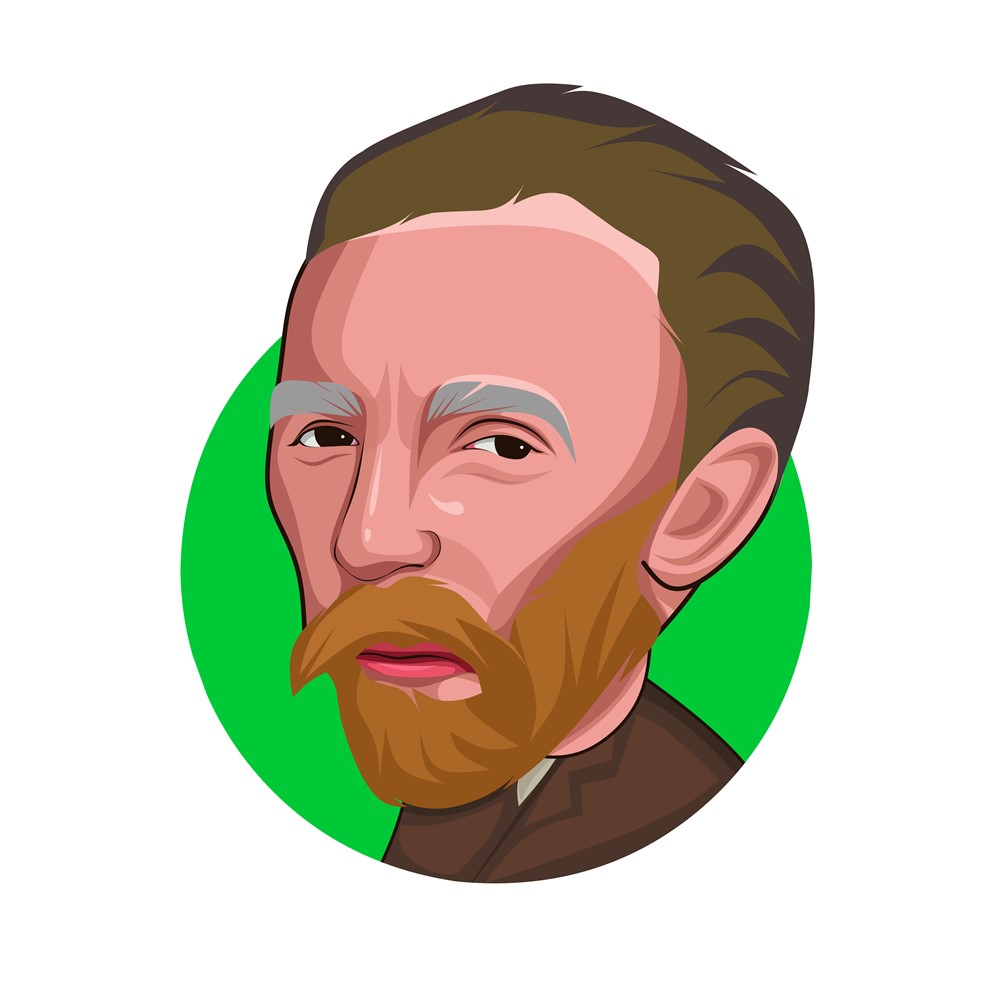
Probably the most famous of the Post-Impressionist painters, Vincent van Gogh was a Dutch painter who lived during the late 19th and early 20th century. He created more than eight hundred oil paintings during his lifetime, which made him a leading figure in Western art history. His most famous works were created during the last two years of his life.

During his early life, Vincent Van Gogh had little interest in the artistic world. He worked with only a fragmentary education. He was influenced by Japanese prints, impressionist techniques, and the works of Peter Paul Rubens. He began painting portraits of friends. He was also a missionary. He wrote over 800 letters.
Vincent Van Gogh was born in a small village in the Brabant region of the Netherlands, where he lived with his family. He was the eldest of six children. He was raised by his father, a Protestant pastor. He had a second brother named Vincent, and a sister named Anna Cornelia Carbentus.
When Vincent was sixteen, he was apprenticed to an art dealership, Goupil & Cie. He was financially supported by his brother, Theo. Theo believed that Vincent’s art would not be well received in Paris. Eventually, Vincent transferred to the art gallery of his uncle, Vincent, who was a partner in the company.
In 1885, Vincent began working on his first masterpiece, Potato Eaters. His style evolved after this point. He began painting in pure colours in the summer of 1887. He also began a series of self-portraits. The subject matter was taken from his rural life. He started out with drawings, but soon switched to oil paintings.
After a short stay in The Hague, Vincent moved to Paris. His uncle, Vincent, was a partner in an art dealer company, Goupil et Cie. He had no formal art education, but Vincent did study on his own. He also studied books on art by Charles Bargue and Jean-Francois Millet. He later became friends with Paul Gauguin.
In the summer of 1882, Vincent traveled to Drenthe, a tiny town in northern Netherlands. He was awed by the museums of Antwerp. He was especially impressed by the works of Rubens. He was also inspired by the works of Derain and Matisse.
Throughout his life, Vincent van Gogh had a number of mental health problems. He was an exceptional painter, but was also known to suffer from several comorbid disorders.
Vincent’s first psychotic episode was short-lived, involving partial amnesia and cognitive dysfunction. In his subsequent episode, he experienced delusions and religious mania.
While it’s unclear what caused Van Gogh’s mania, experts agree that alcohol use was likely a contributing factor. This, along with the fact that he suffered from several comorbid illnesses, may have worsened his condition.
One of the more impressive features of Van Gogh’s cycloid psychosis was that he was able to paint during less-severe symptoms. Unfortunately, he was unable to fully recover from his symptoms, and spent a great deal of time in a psychiatric hospital.
His letters provide us with some details about his psychotic episodes, but they are not detailed enough to accurately determine what his illness was. A number of experts have tried to pin down the cause of his illness, but they have been hampered by a lack of information.
A study of his life by Marshal Sanches, associate professor of psychiatry at McGovern Medical School at UTHealth, has shed some light on Van Gogh’s health. His paintings are a good indicator of the early signs of bipolar disorder. He was also treated for chronic kidney disease, and for gonorrhea.
While Van Gogh’s life was not a happy one, he did make a number of accomplishments. He had a unique ability to convey supernatural intensity through color. He also had a strong willpower and resilience. Despite his struggles, he did not give up. He wrote over 800 letters during his lifetime.
Despite being considered a great artist, Vincent van Gogh’s illness was a serious and ongoing problem. The artist experienced numerous comorbid disorders, including seizures, syphilis, acute intermittent porphyria, saturnine encephalopathy, lead poisoning, and chronic kidney disease.
In 1888, after experiencing a strange event, Vincent Van Gogh was admitted to hospital in Arles, France. He was diagnosed with “syphilis” by Dr. Cavenaille. However, the diagnosis was not confirmed by physicians caring for Vincent in the hospital.
In June of 1889, Van Gogh painted his famous Starry Night. He also painted a series of paintings called the Reminiscences of the North. These works of art convey a supernatural intensity through color.
Van Gogh’s illness was so severe that he cut off part of his ear. He was then put into an asylum and tried to commit suicide. The case remains controversial. Some researchers believe that van Gogh suffered from a psychiatric illness.
Others believe that he was suffering from alcohol withdrawal. This may have contributed to his delirium after he abruptly stopped drinking. It has been suggested that the intense psychotic symptoms of Van Gogh may have led him to cut off his ear.
A few other possible comorbidities are borderline personality disorder, substance use disorder, depression, schizophrenia, and bipolar mood disorder. In addition, he may have had an early temporal limbic lesion.
While most artists have a history of bipolar depression and/or bipolar disorder, Vincent Van Gogh’s illness was very different. He had periods of mania, hypomania, and prolonged depressive episodes. He also experienced seizures and hallucinations.
He did not exhibit negative symptoms of schizophrenia, but was not fully recovered from his psychotic features. He had a long history of alcohol consumption, which probably contributed to his lack of success as an artist.
During the period when he studied art in Paris, Vincent Van Gogh developed his style and palette. His work is known for its bold color and heavy lay-on of paint. These elements give his paintings a unique texture.
Vincent Van Gogh started out using a dark earthy palette, but soon introduced brighter colors. He was fascinated by the sunlight in southern France, and began to paint images of the landscape. In the summer, he painted yellow fields and blossom trees. In winter, he painted snow scenes. He also worked on still-life paintings of flowers.
In the early days of his career, Vincent was inspired by the work of Impressionists, including Camille Pissarro and Georges Seurat. He borrowed techniques from these artists, such as contouring objects with dark outlines. He also drew a grid on the canvas to help correct the depth of field in his landscapes.
Vincent began to experiment with short brushstrokes and less-contrast color. He also became familiar with Japanese prints. He was also impressed by the Neo-Impressionists’ work, especially that of Georges Seurat.
His style evolved slowly, and his works show a gradual shift from anatomically accurate to eccentric. His most important symbols are movement, choppy brushstrokes, and a heavily-textured look.
In February 1888, Vincent moved to Arles, south of France. He met Gauguin, a friend of his brother Theo. The two artists clashed over their art and threatened to become violent. However, the pair eventually became friends and collaborated on several projects.
During this time, Van Gogh was inspired by the work of artists such as Claude Monet and Edgar Degas. His work gradually moved away from realistic portraiture to include landscapes in the proper perspective.
During the course of his life, Vincent Van Gogh had a long love affair with a woman named Sien Hoornik. They dated for nearly two years. Eventually, they ended their relationship.
In 1883, Vincent visited Drenthe in the Netherlands. He spent three months in this region. He grew tired of the city life, and wanted to look at nature under a brighter sky. He made a few paintings in the town.
Then, in May 1890, Vincent went to Paris. He met up with Paul Gauguin. The two became friends. They walked together. They both longed to see the north. They were concerned about Van Gogh’s condition. They offered to watch over him.
While in France, Vincent was exposed to the full effect of modern art. He found the dark palette in Holland was outdated. He grew enthralled with the full impact of colour. He began to draw from live models instead of hiring models. He also experimented with oil paint. He began producing vibrant masterpieces.
Later, Vincent went to England to work as an assistant teacher. He was financially dependent on his brother, Theo. They had a serious relationship, but eventually broke up. Theo contracted syphilis, and died six months after Van Gogh. Theo’s widow inherited a large collection of Vincent’s work.
Vincent’s cousin, Anton Mauve, was a painter. He was scandalized by the relationship between Vincent and Hoornik. He encouraged van Gogh to break up with her. He then moved on to another girl, Clasina Maria Hoornik. She was a prostitute, and had an illegitimate child. She became van Gogh’s companion. She had a young family.
After Van Gogh’s death, Jo van Gogh-Bonger published a book of letters. The collection was published in 1914. It contains letters from Vincent to his brother Theo. Students can read these letters to better understand the subject matter. You can also explore online exhibits that describe Van Gogh’s love life.
Max Ernst Among the most famous artists of the twentieth century, Max Ernst was a
Angelina Jolie DCMG – An Icon in Hollywood Whether you love her as an actress
Barack Hussein Obama II Barack Hussein Obama II served as the 44th President of the
A Brief Look at Ben Affleck Benjamin Affleck is a well-known American actor and director.
Alicia Keys Alicia Keys is a famous American singer, songwriter and pianist. She was born